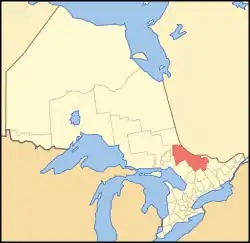Nipissing District
Nipissing District is a district in Northeastern Ontario in the Canadian province of Ontario. It was created in 1858. The district seat is North Bay.
Nipissing District
District de Nipissing | |
|---|---|
 Location of Nipissing District in Ontario | |
| Coordinates: 46°18′00″N 79°27′00″W | |
| Country | |
| Province | |
| Region | Northeastern Ontario |
| Created | 1858 |
| Government | |
| • MPs | Anthony Rota, Cheryl Gallant, Marc Serré |
| • MPPs | Vic Fedeli, John Vanthof, John Yakabuski |
| Area | |
| • Land | 17,103.52 km2 (6,603.71 sq mi) |
| Population (2016)[2] | |
| • Total | 83,150 |
| • Density | 4.9/km2 (13/sq mi) |
| Time zone | UTC-5 (Eastern (EST)) |
| • Summer (DST) | UTC-4 (EDT) |
| Postal code FSA | |
| Area code | 705 |
| Seat | North Bay |
In 2016, the population was 83,150. The land area is 17,103.52 square kilometres (6,603.71 sq mi); the population density was 4.9 per square kilometre (13/sq mi), making it one of the most densely populated districts in northern Ontario.[1]
History
The Sudbury District was created in 1894 from townships of eastern Algoma District and west Nipissing District. The Timiskaming District was created in 1912 from parts of Algoma, Nipissing, and Sudbury Districts.
Subdivisions
City
Towns
In addition, the eastern part of the town of Kearney is within Nipissing District, but the entire town is enumerated with the Parry Sound District.
Unorganized areas
Local services boards in these unorganized areas include:
First Nation reserves
Demographics
As a census division in the 2021 Census of Population conducted by Statistics Canada, the Nipissing District had a population of 84,716 living in 37,252 of its 41,974 total private dwellings, a change of 1.9% from its 2016 population of 83,150. With a land area of 16,986.2 km2 (6,558.4 sq mi), it had a population density of 5.0/km2 (12.9/sq mi) in 2021.[3]
| 2021 | 2016 | 2011 | |
|---|---|---|---|
| Population | 84,716 (+1.9% from 2016) | 83,150 (-1.9% from 2011) | 84,736 (0.1% from 2006) |
| Land area | 16,986.20 km2 (6,558.41 sq mi) | 17,103.52 km2 (6,603.71 sq mi) | |
| Population density | 5/km2 (13/sq mi) | 5.0/km2 (13/sq mi) | |
| Median age | 46.8 (M: 45.6, F: 48) | ||
| Private dwellings | 37,250 (total) | 41,200 (total) | 41,023 (total) |
| Median household income |
See also
References
- "2011 Community Profiles". 2011 Canadian Census. Statistics Canada. March 21, 2019. Retrieved 2012-03-19.
- "2016 Community Profiles". 2016 Canadian Census. Statistics Canada. August 12, 2021.
- "Population and dwelling counts: Canada and census divisions". Statistics Canada. February 9, 2022. Retrieved April 2, 2022.
- "2021 Community Profiles". 2021 Canadian Census. Statistics Canada. February 4, 2022. Retrieved 2022-04-27.
- "2006 Community Profiles". 2006 Canadian Census. Statistics Canada. August 20, 2019.
- "2001 Community Profiles". 2001 Canadian Census. Statistics Canada. July 18, 2021.
